Social Practices with Children
VerifiedAdded on 2023/03/30
|8
|2053
|205
AI Summary
This article discusses the social systems theory and its impact on children's behavior. It analyzes the case study of The Askin Family and explores the factors influencing their 12-year-old son's behavior. The article also delves into the theories of psychosexual and psychosocial development and their relevance in shaping a child's personality.
Contribute Materials
Your contribution can guide someone’s learning journey. Share your
documents today.
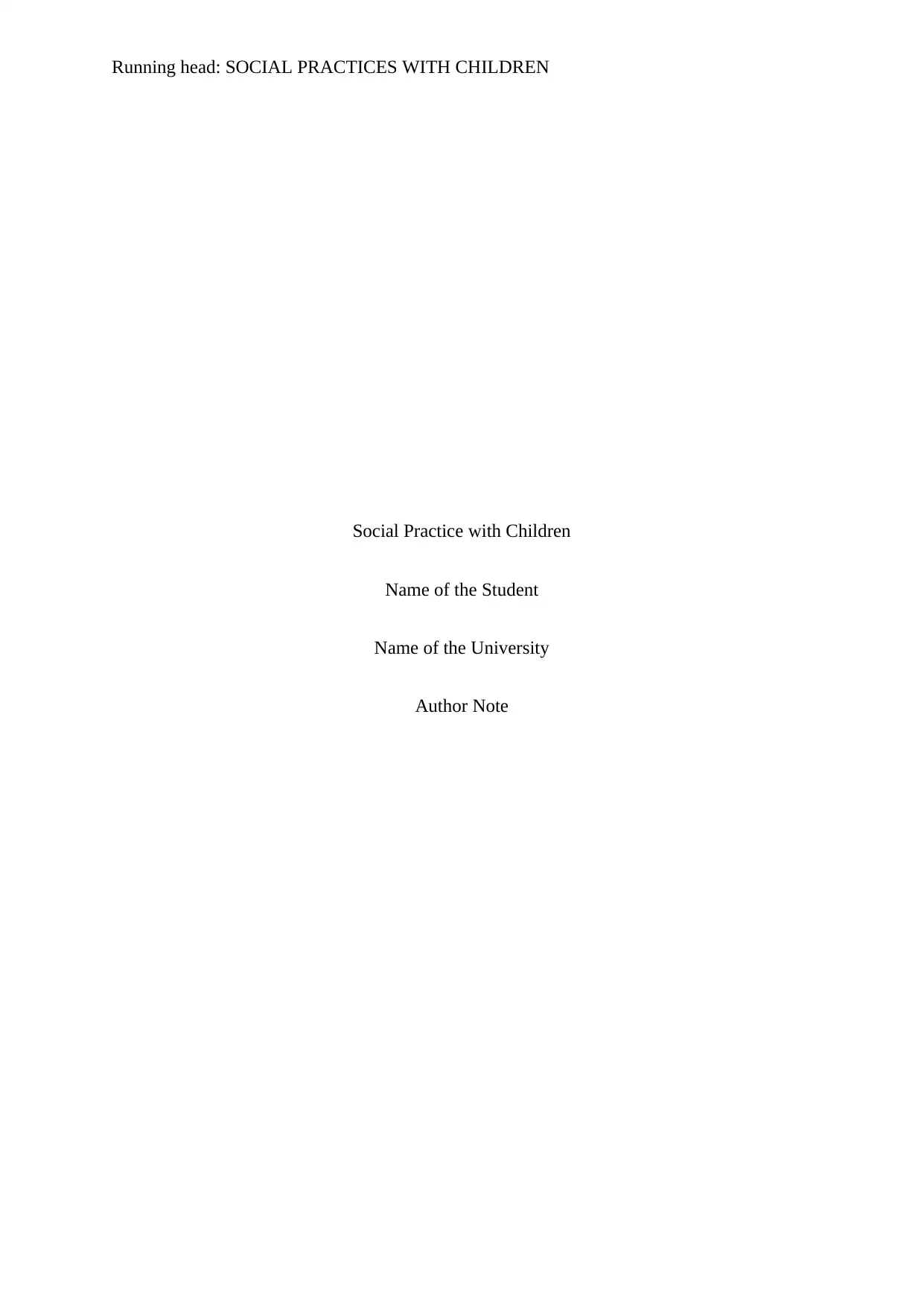
Running head: SOCIAL PRACTICES WITH CHILDREN
Social Practice with Children
Name of the Student
Name of the University
Author Note
Social Practice with Children
Name of the Student
Name of the University
Author Note
Secure Best Marks with AI Grader
Need help grading? Try our AI Grader for instant feedback on your assignments.
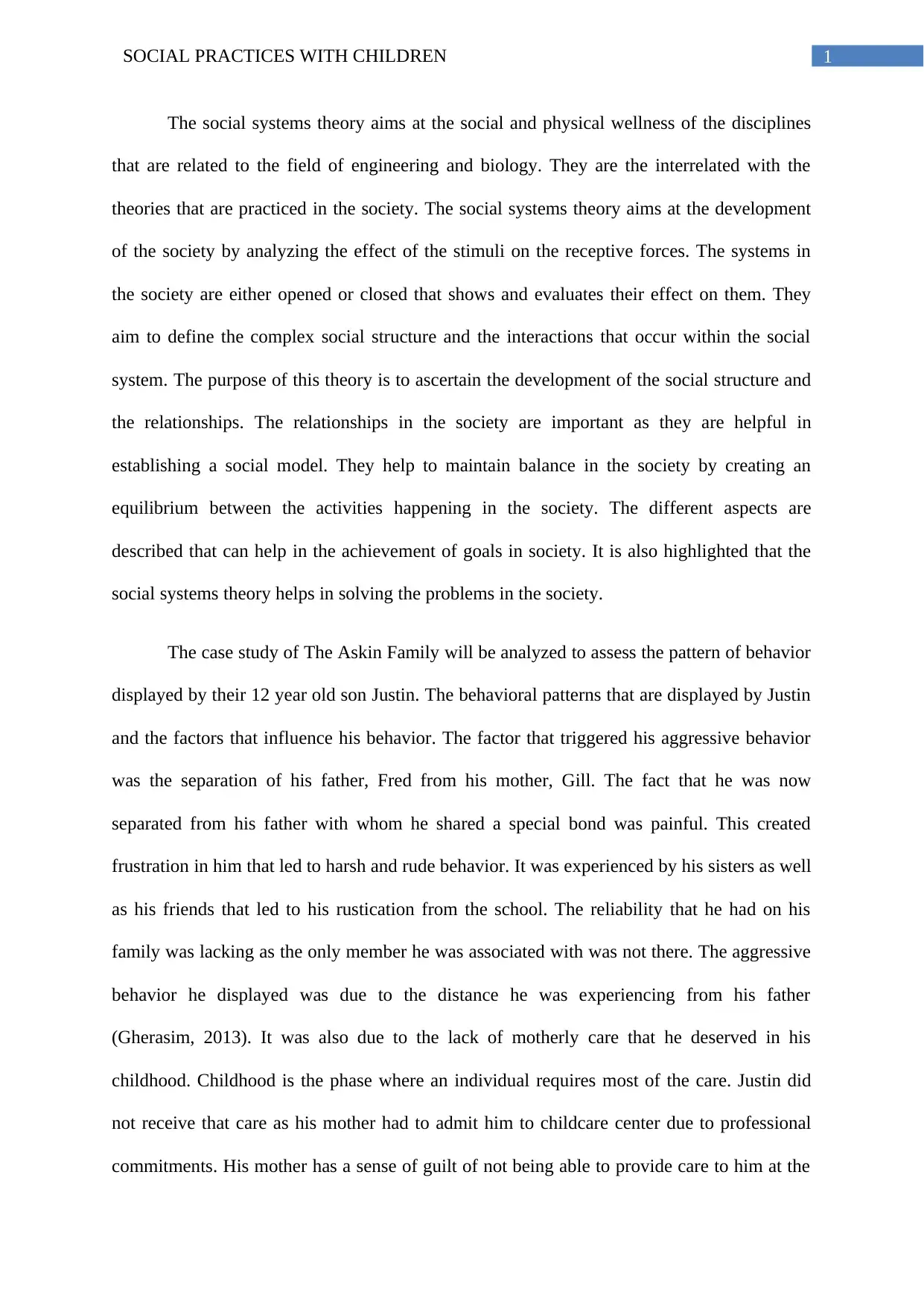
1SOCIAL PRACTICES WITH CHILDREN
The social systems theory aims at the social and physical wellness of the disciplines
that are related to the field of engineering and biology. They are the interrelated with the
theories that are practiced in the society. The social systems theory aims at the development
of the society by analyzing the effect of the stimuli on the receptive forces. The systems in
the society are either opened or closed that shows and evaluates their effect on them. They
aim to define the complex social structure and the interactions that occur within the social
system. The purpose of this theory is to ascertain the development of the social structure and
the relationships. The relationships in the society are important as they are helpful in
establishing a social model. They help to maintain balance in the society by creating an
equilibrium between the activities happening in the society. The different aspects are
described that can help in the achievement of goals in society. It is also highlighted that the
social systems theory helps in solving the problems in the society.
The case study of The Askin Family will be analyzed to assess the pattern of behavior
displayed by their 12 year old son Justin. The behavioral patterns that are displayed by Justin
and the factors that influence his behavior. The factor that triggered his aggressive behavior
was the separation of his father, Fred from his mother, Gill. The fact that he was now
separated from his father with whom he shared a special bond was painful. This created
frustration in him that led to harsh and rude behavior. It was experienced by his sisters as well
as his friends that led to his rustication from the school. The reliability that he had on his
family was lacking as the only member he was associated with was not there. The aggressive
behavior he displayed was due to the distance he was experiencing from his father
(Gherasim, 2013). It was also due to the lack of motherly care that he deserved in his
childhood. Childhood is the phase where an individual requires most of the care. Justin did
not receive that care as his mother had to admit him to childcare center due to professional
commitments. His mother has a sense of guilt of not being able to provide care to him at the
The social systems theory aims at the social and physical wellness of the disciplines
that are related to the field of engineering and biology. They are the interrelated with the
theories that are practiced in the society. The social systems theory aims at the development
of the society by analyzing the effect of the stimuli on the receptive forces. The systems in
the society are either opened or closed that shows and evaluates their effect on them. They
aim to define the complex social structure and the interactions that occur within the social
system. The purpose of this theory is to ascertain the development of the social structure and
the relationships. The relationships in the society are important as they are helpful in
establishing a social model. They help to maintain balance in the society by creating an
equilibrium between the activities happening in the society. The different aspects are
described that can help in the achievement of goals in society. It is also highlighted that the
social systems theory helps in solving the problems in the society.
The case study of The Askin Family will be analyzed to assess the pattern of behavior
displayed by their 12 year old son Justin. The behavioral patterns that are displayed by Justin
and the factors that influence his behavior. The factor that triggered his aggressive behavior
was the separation of his father, Fred from his mother, Gill. The fact that he was now
separated from his father with whom he shared a special bond was painful. This created
frustration in him that led to harsh and rude behavior. It was experienced by his sisters as well
as his friends that led to his rustication from the school. The reliability that he had on his
family was lacking as the only member he was associated with was not there. The aggressive
behavior he displayed was due to the distance he was experiencing from his father
(Gherasim, 2013). It was also due to the lack of motherly care that he deserved in his
childhood. Childhood is the phase where an individual requires most of the care. Justin did
not receive that care as his mother had to admit him to childcare center due to professional
commitments. His mother has a sense of guilt of not being able to provide care to him at the
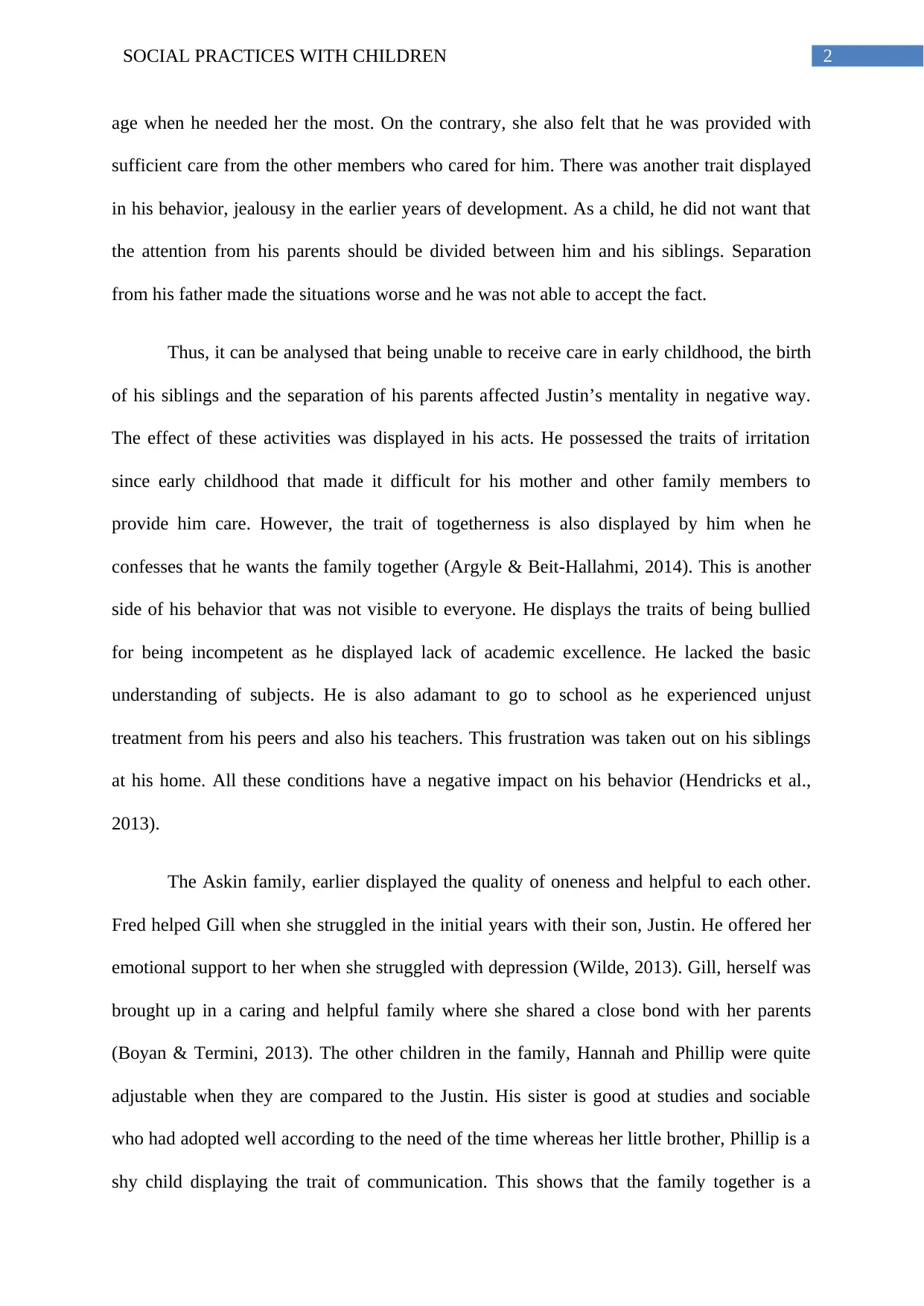
2SOCIAL PRACTICES WITH CHILDREN
age when he needed her the most. On the contrary, she also felt that he was provided with
sufficient care from the other members who cared for him. There was another trait displayed
in his behavior, jealousy in the earlier years of development. As a child, he did not want that
the attention from his parents should be divided between him and his siblings. Separation
from his father made the situations worse and he was not able to accept the fact.
Thus, it can be analysed that being unable to receive care in early childhood, the birth
of his siblings and the separation of his parents affected Justin’s mentality in negative way.
The effect of these activities was displayed in his acts. He possessed the traits of irritation
since early childhood that made it difficult for his mother and other family members to
provide him care. However, the trait of togetherness is also displayed by him when he
confesses that he wants the family together (Argyle & Beit-Hallahmi, 2014). This is another
side of his behavior that was not visible to everyone. He displays the traits of being bullied
for being incompetent as he displayed lack of academic excellence. He lacked the basic
understanding of subjects. He is also adamant to go to school as he experienced unjust
treatment from his peers and also his teachers. This frustration was taken out on his siblings
at his home. All these conditions have a negative impact on his behavior (Hendricks et al.,
2013).
The Askin family, earlier displayed the quality of oneness and helpful to each other.
Fred helped Gill when she struggled in the initial years with their son, Justin. He offered her
emotional support to her when she struggled with depression (Wilde, 2013). Gill, herself was
brought up in a caring and helpful family where she shared a close bond with her parents
(Boyan & Termini, 2013). The other children in the family, Hannah and Phillip were quite
adjustable when they are compared to the Justin. His sister is good at studies and sociable
who had adopted well according to the need of the time whereas her little brother, Phillip is a
shy child displaying the trait of communication. This shows that the family together is a
age when he needed her the most. On the contrary, she also felt that he was provided with
sufficient care from the other members who cared for him. There was another trait displayed
in his behavior, jealousy in the earlier years of development. As a child, he did not want that
the attention from his parents should be divided between him and his siblings. Separation
from his father made the situations worse and he was not able to accept the fact.
Thus, it can be analysed that being unable to receive care in early childhood, the birth
of his siblings and the separation of his parents affected Justin’s mentality in negative way.
The effect of these activities was displayed in his acts. He possessed the traits of irritation
since early childhood that made it difficult for his mother and other family members to
provide him care. However, the trait of togetherness is also displayed by him when he
confesses that he wants the family together (Argyle & Beit-Hallahmi, 2014). This is another
side of his behavior that was not visible to everyone. He displays the traits of being bullied
for being incompetent as he displayed lack of academic excellence. He lacked the basic
understanding of subjects. He is also adamant to go to school as he experienced unjust
treatment from his peers and also his teachers. This frustration was taken out on his siblings
at his home. All these conditions have a negative impact on his behavior (Hendricks et al.,
2013).
The Askin family, earlier displayed the quality of oneness and helpful to each other.
Fred helped Gill when she struggled in the initial years with their son, Justin. He offered her
emotional support to her when she struggled with depression (Wilde, 2013). Gill, herself was
brought up in a caring and helpful family where she shared a close bond with her parents
(Boyan & Termini, 2013). The other children in the family, Hannah and Phillip were quite
adjustable when they are compared to the Justin. His sister is good at studies and sociable
who had adopted well according to the need of the time whereas her little brother, Phillip is a
shy child displaying the trait of communication. This shows that the family together is a
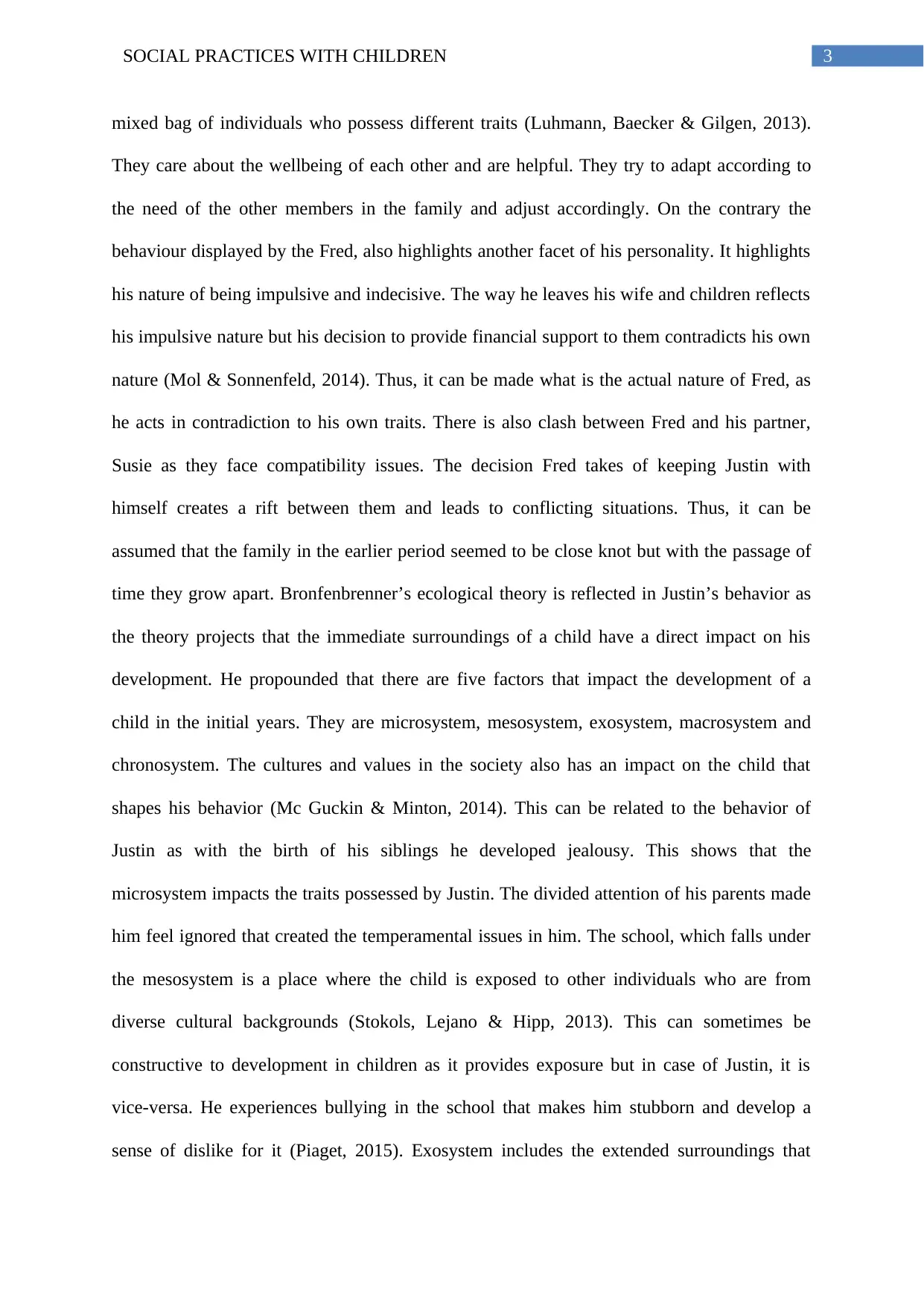
3SOCIAL PRACTICES WITH CHILDREN
mixed bag of individuals who possess different traits (Luhmann, Baecker & Gilgen, 2013).
They care about the wellbeing of each other and are helpful. They try to adapt according to
the need of the other members in the family and adjust accordingly. On the contrary the
behaviour displayed by the Fred, also highlights another facet of his personality. It highlights
his nature of being impulsive and indecisive. The way he leaves his wife and children reflects
his impulsive nature but his decision to provide financial support to them contradicts his own
nature (Mol & Sonnenfeld, 2014). Thus, it can be made what is the actual nature of Fred, as
he acts in contradiction to his own traits. There is also clash between Fred and his partner,
Susie as they face compatibility issues. The decision Fred takes of keeping Justin with
himself creates a rift between them and leads to conflicting situations. Thus, it can be
assumed that the family in the earlier period seemed to be close knot but with the passage of
time they grow apart. Bronfenbrenner’s ecological theory is reflected in Justin’s behavior as
the theory projects that the immediate surroundings of a child have a direct impact on his
development. He propounded that there are five factors that impact the development of a
child in the initial years. They are microsystem, mesosystem, exosystem, macrosystem and
chronosystem. The cultures and values in the society also has an impact on the child that
shapes his behavior (Mc Guckin & Minton, 2014). This can be related to the behavior of
Justin as with the birth of his siblings he developed jealousy. This shows that the
microsystem impacts the traits possessed by Justin. The divided attention of his parents made
him feel ignored that created the temperamental issues in him. The school, which falls under
the mesosystem is a place where the child is exposed to other individuals who are from
diverse cultural backgrounds (Stokols, Lejano & Hipp, 2013). This can sometimes be
constructive to development in children as it provides exposure but in case of Justin, it is
vice-versa. He experiences bullying in the school that makes him stubborn and develop a
sense of dislike for it (Piaget, 2015). Exosystem includes the extended surroundings that
mixed bag of individuals who possess different traits (Luhmann, Baecker & Gilgen, 2013).
They care about the wellbeing of each other and are helpful. They try to adapt according to
the need of the other members in the family and adjust accordingly. On the contrary the
behaviour displayed by the Fred, also highlights another facet of his personality. It highlights
his nature of being impulsive and indecisive. The way he leaves his wife and children reflects
his impulsive nature but his decision to provide financial support to them contradicts his own
nature (Mol & Sonnenfeld, 2014). Thus, it can be made what is the actual nature of Fred, as
he acts in contradiction to his own traits. There is also clash between Fred and his partner,
Susie as they face compatibility issues. The decision Fred takes of keeping Justin with
himself creates a rift between them and leads to conflicting situations. Thus, it can be
assumed that the family in the earlier period seemed to be close knot but with the passage of
time they grow apart. Bronfenbrenner’s ecological theory is reflected in Justin’s behavior as
the theory projects that the immediate surroundings of a child have a direct impact on his
development. He propounded that there are five factors that impact the development of a
child in the initial years. They are microsystem, mesosystem, exosystem, macrosystem and
chronosystem. The cultures and values in the society also has an impact on the child that
shapes his behavior (Mc Guckin & Minton, 2014). This can be related to the behavior of
Justin as with the birth of his siblings he developed jealousy. This shows that the
microsystem impacts the traits possessed by Justin. The divided attention of his parents made
him feel ignored that created the temperamental issues in him. The school, which falls under
the mesosystem is a place where the child is exposed to other individuals who are from
diverse cultural backgrounds (Stokols, Lejano & Hipp, 2013). This can sometimes be
constructive to development in children as it provides exposure but in case of Justin, it is
vice-versa. He experiences bullying in the school that makes him stubborn and develop a
sense of dislike for it (Piaget, 2015). Exosystem includes the extended surroundings that
Secure Best Marks with AI Grader
Need help grading? Try our AI Grader for instant feedback on your assignments.
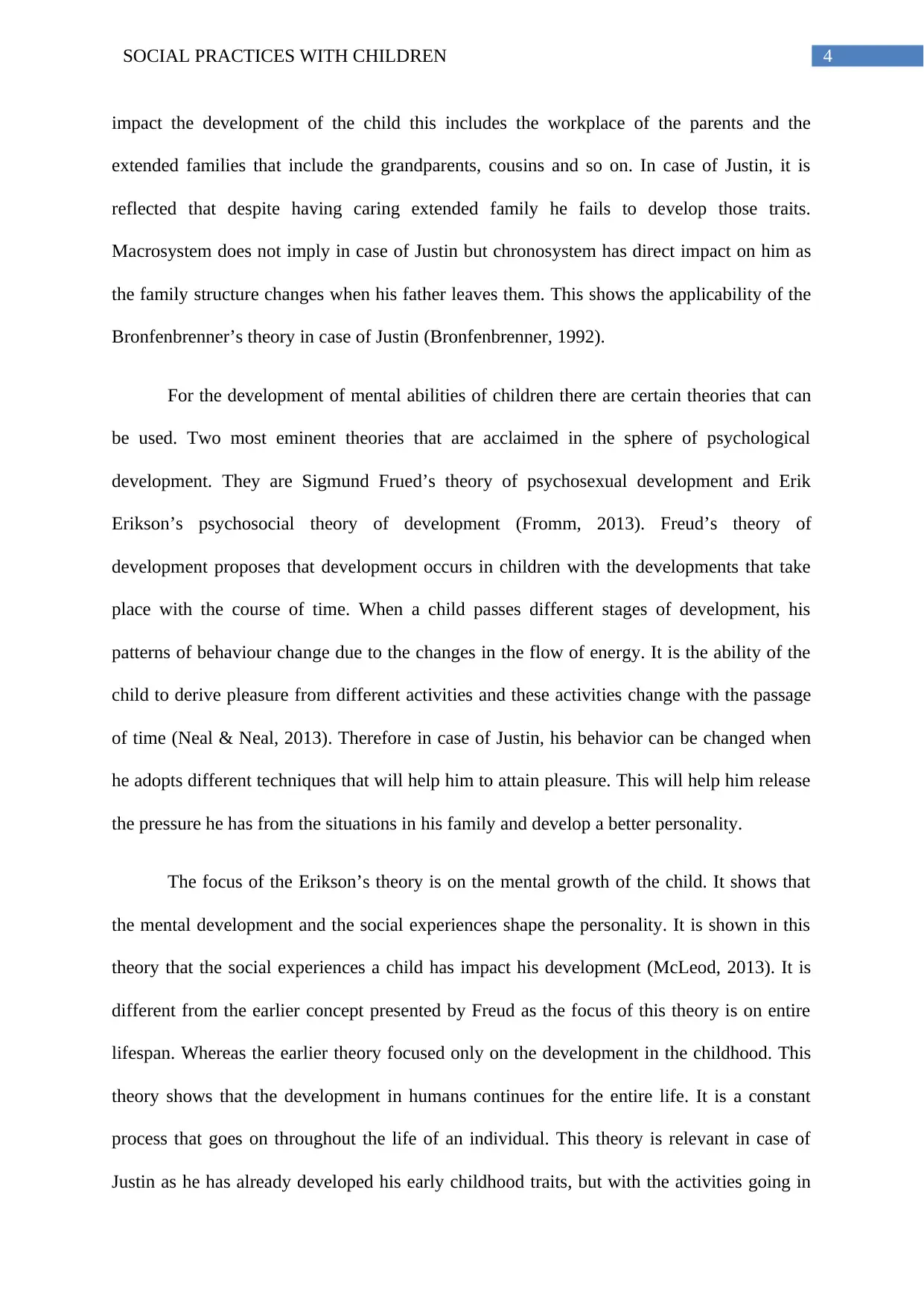
4SOCIAL PRACTICES WITH CHILDREN
impact the development of the child this includes the workplace of the parents and the
extended families that include the grandparents, cousins and so on. In case of Justin, it is
reflected that despite having caring extended family he fails to develop those traits.
Macrosystem does not imply in case of Justin but chronosystem has direct impact on him as
the family structure changes when his father leaves them. This shows the applicability of the
Bronfenbrenner’s theory in case of Justin (Bronfenbrenner, 1992).
For the development of mental abilities of children there are certain theories that can
be used. Two most eminent theories that are acclaimed in the sphere of psychological
development. They are Sigmund Frued’s theory of psychosexual development and Erik
Erikson’s psychosocial theory of development (Fromm, 2013). Freud’s theory of
development proposes that development occurs in children with the developments that take
place with the course of time. When a child passes different stages of development, his
patterns of behaviour change due to the changes in the flow of energy. It is the ability of the
child to derive pleasure from different activities and these activities change with the passage
of time (Neal & Neal, 2013). Therefore in case of Justin, his behavior can be changed when
he adopts different techniques that will help him to attain pleasure. This will help him release
the pressure he has from the situations in his family and develop a better personality.
The focus of the Erikson’s theory is on the mental growth of the child. It shows that
the mental development and the social experiences shape the personality. It is shown in this
theory that the social experiences a child has impact his development (McLeod, 2013). It is
different from the earlier concept presented by Freud as the focus of this theory is on entire
lifespan. Whereas the earlier theory focused only on the development in the childhood. This
theory shows that the development in humans continues for the entire life. It is a constant
process that goes on throughout the life of an individual. This theory is relevant in case of
Justin as he has already developed his early childhood traits, but with the activities going in
impact the development of the child this includes the workplace of the parents and the
extended families that include the grandparents, cousins and so on. In case of Justin, it is
reflected that despite having caring extended family he fails to develop those traits.
Macrosystem does not imply in case of Justin but chronosystem has direct impact on him as
the family structure changes when his father leaves them. This shows the applicability of the
Bronfenbrenner’s theory in case of Justin (Bronfenbrenner, 1992).
For the development of mental abilities of children there are certain theories that can
be used. Two most eminent theories that are acclaimed in the sphere of psychological
development. They are Sigmund Frued’s theory of psychosexual development and Erik
Erikson’s psychosocial theory of development (Fromm, 2013). Freud’s theory of
development proposes that development occurs in children with the developments that take
place with the course of time. When a child passes different stages of development, his
patterns of behaviour change due to the changes in the flow of energy. It is the ability of the
child to derive pleasure from different activities and these activities change with the passage
of time (Neal & Neal, 2013). Therefore in case of Justin, his behavior can be changed when
he adopts different techniques that will help him to attain pleasure. This will help him release
the pressure he has from the situations in his family and develop a better personality.
The focus of the Erikson’s theory is on the mental growth of the child. It shows that
the mental development and the social experiences shape the personality. It is shown in this
theory that the social experiences a child has impact his development (McLeod, 2013). It is
different from the earlier concept presented by Freud as the focus of this theory is on entire
lifespan. Whereas the earlier theory focused only on the development in the childhood. This
theory shows that the development in humans continues for the entire life. It is a constant
process that goes on throughout the life of an individual. This theory is relevant in case of
Justin as he has already developed his early childhood traits, but with the activities going in
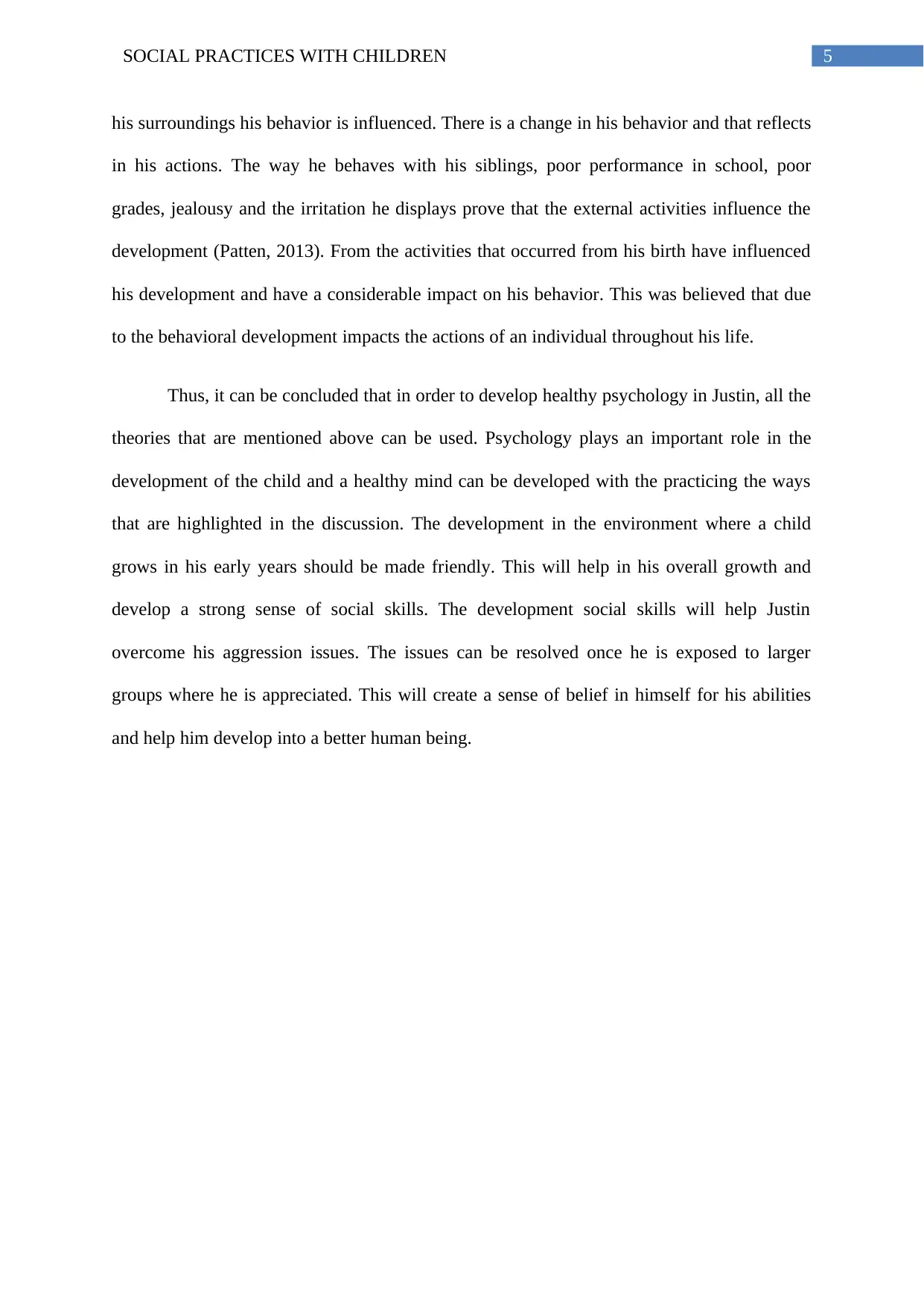
5SOCIAL PRACTICES WITH CHILDREN
his surroundings his behavior is influenced. There is a change in his behavior and that reflects
in his actions. The way he behaves with his siblings, poor performance in school, poor
grades, jealousy and the irritation he displays prove that the external activities influence the
development (Patten, 2013). From the activities that occurred from his birth have influenced
his development and have a considerable impact on his behavior. This was believed that due
to the behavioral development impacts the actions of an individual throughout his life.
Thus, it can be concluded that in order to develop healthy psychology in Justin, all the
theories that are mentioned above can be used. Psychology plays an important role in the
development of the child and a healthy mind can be developed with the practicing the ways
that are highlighted in the discussion. The development in the environment where a child
grows in his early years should be made friendly. This will help in his overall growth and
develop a strong sense of social skills. The development social skills will help Justin
overcome his aggression issues. The issues can be resolved once he is exposed to larger
groups where he is appreciated. This will create a sense of belief in himself for his abilities
and help him develop into a better human being.
his surroundings his behavior is influenced. There is a change in his behavior and that reflects
in his actions. The way he behaves with his siblings, poor performance in school, poor
grades, jealousy and the irritation he displays prove that the external activities influence the
development (Patten, 2013). From the activities that occurred from his birth have influenced
his development and have a considerable impact on his behavior. This was believed that due
to the behavioral development impacts the actions of an individual throughout his life.
Thus, it can be concluded that in order to develop healthy psychology in Justin, all the
theories that are mentioned above can be used. Psychology plays an important role in the
development of the child and a healthy mind can be developed with the practicing the ways
that are highlighted in the discussion. The development in the environment where a child
grows in his early years should be made friendly. This will help in his overall growth and
develop a strong sense of social skills. The development social skills will help Justin
overcome his aggression issues. The issues can be resolved once he is exposed to larger
groups where he is appreciated. This will create a sense of belief in himself for his abilities
and help him develop into a better human being.
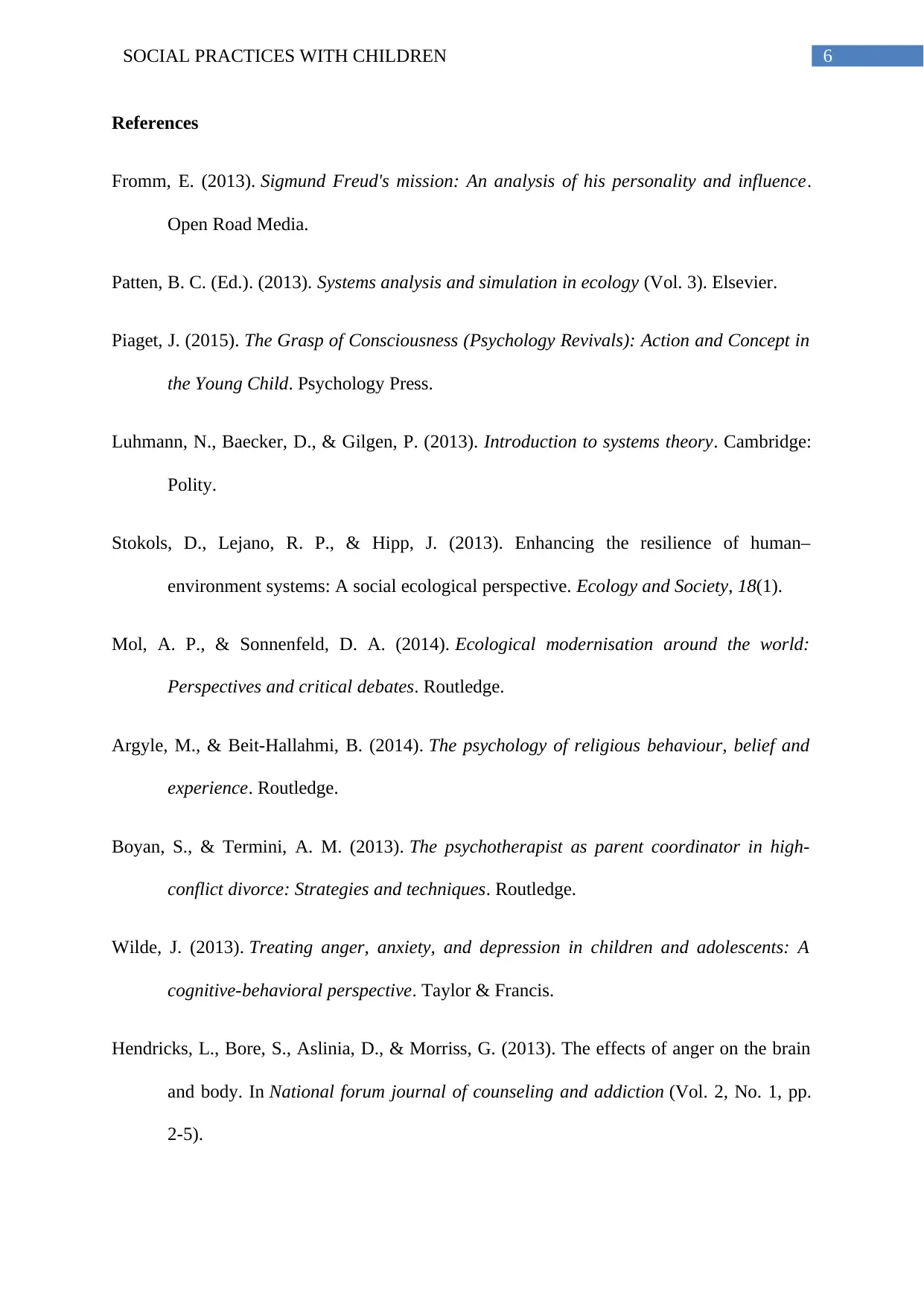
6SOCIAL PRACTICES WITH CHILDREN
References
Fromm, E. (2013). Sigmund Freud's mission: An analysis of his personality and influence.
Open Road Media.
Patten, B. C. (Ed.). (2013). Systems analysis and simulation in ecology (Vol. 3). Elsevier.
Piaget, J. (2015). The Grasp of Consciousness (Psychology Revivals): Action and Concept in
the Young Child. Psychology Press.
Luhmann, N., Baecker, D., & Gilgen, P. (2013). Introduction to systems theory. Cambridge:
Polity.
Stokols, D., Lejano, R. P., & Hipp, J. (2013). Enhancing the resilience of human–
environment systems: A social ecological perspective. Ecology and Society, 18(1).
Mol, A. P., & Sonnenfeld, D. A. (2014). Ecological modernisation around the world:
Perspectives and critical debates. Routledge.
Argyle, M., & Beit-Hallahmi, B. (2014). The psychology of religious behaviour, belief and
experience. Routledge.
Boyan, S., & Termini, A. M. (2013). The psychotherapist as parent coordinator in high-
conflict divorce: Strategies and techniques. Routledge.
Wilde, J. (2013). Treating anger, anxiety, and depression in children and adolescents: A
cognitive-behavioral perspective. Taylor & Francis.
Hendricks, L., Bore, S., Aslinia, D., & Morriss, G. (2013). The effects of anger on the brain
and body. In National forum journal of counseling and addiction (Vol. 2, No. 1, pp.
2-5).
References
Fromm, E. (2013). Sigmund Freud's mission: An analysis of his personality and influence.
Open Road Media.
Patten, B. C. (Ed.). (2013). Systems analysis and simulation in ecology (Vol. 3). Elsevier.
Piaget, J. (2015). The Grasp of Consciousness (Psychology Revivals): Action and Concept in
the Young Child. Psychology Press.
Luhmann, N., Baecker, D., & Gilgen, P. (2013). Introduction to systems theory. Cambridge:
Polity.
Stokols, D., Lejano, R. P., & Hipp, J. (2013). Enhancing the resilience of human–
environment systems: A social ecological perspective. Ecology and Society, 18(1).
Mol, A. P., & Sonnenfeld, D. A. (2014). Ecological modernisation around the world:
Perspectives and critical debates. Routledge.
Argyle, M., & Beit-Hallahmi, B. (2014). The psychology of religious behaviour, belief and
experience. Routledge.
Boyan, S., & Termini, A. M. (2013). The psychotherapist as parent coordinator in high-
conflict divorce: Strategies and techniques. Routledge.
Wilde, J. (2013). Treating anger, anxiety, and depression in children and adolescents: A
cognitive-behavioral perspective. Taylor & Francis.
Hendricks, L., Bore, S., Aslinia, D., & Morriss, G. (2013). The effects of anger on the brain
and body. In National forum journal of counseling and addiction (Vol. 2, No. 1, pp.
2-5).
Paraphrase This Document
Need a fresh take? Get an instant paraphrase of this document with our AI Paraphraser
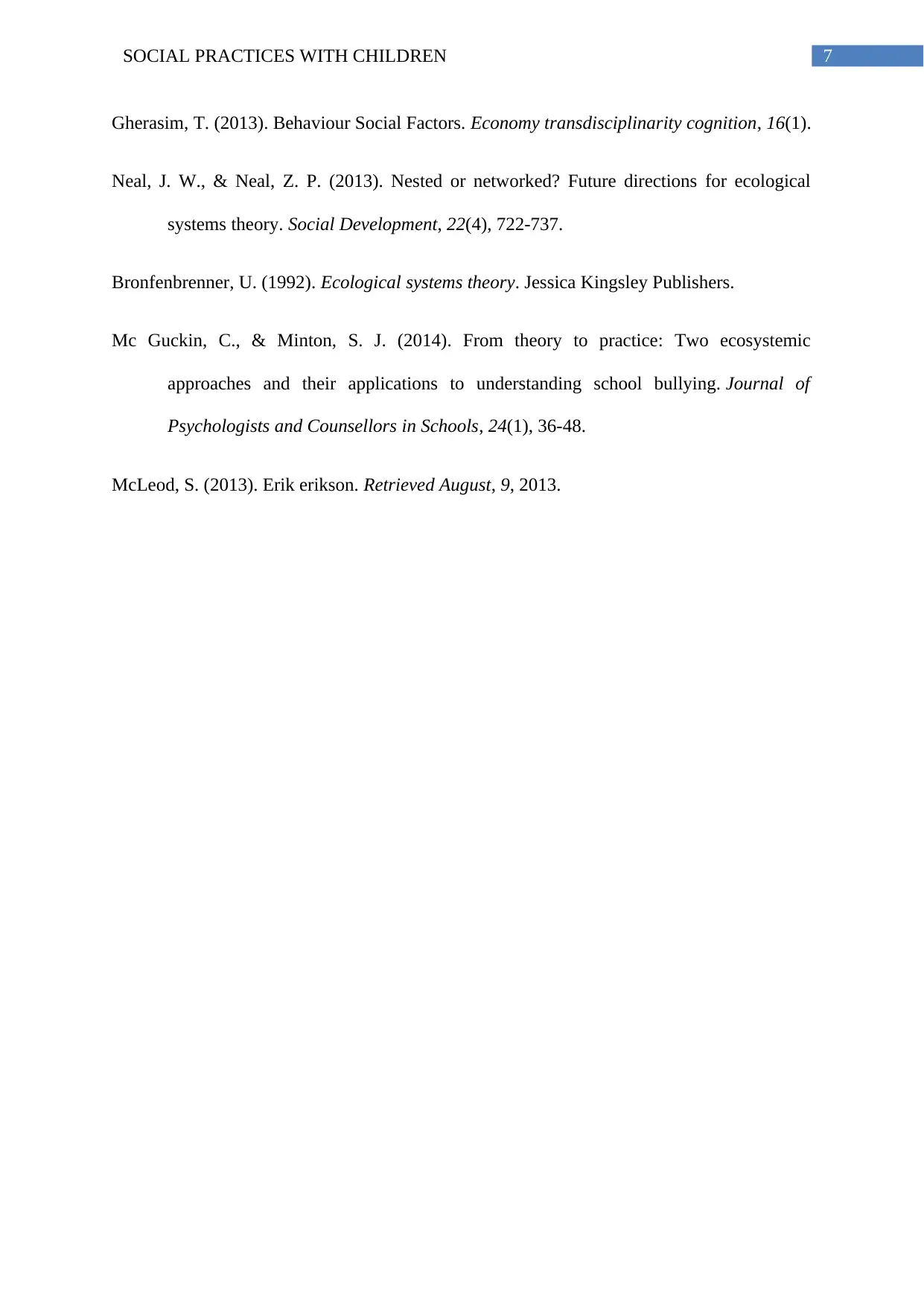
7SOCIAL PRACTICES WITH CHILDREN
Gherasim, T. (2013). Behaviour Social Factors. Economy transdisciplinarity cognition, 16(1).
Neal, J. W., & Neal, Z. P. (2013). Nested or networked? Future directions for ecological
systems theory. Social Development, 22(4), 722-737.
Bronfenbrenner, U. (1992). Ecological systems theory. Jessica Kingsley Publishers.
Mc Guckin, C., & Minton, S. J. (2014). From theory to practice: Two ecosystemic
approaches and their applications to understanding school bullying. Journal of
Psychologists and Counsellors in Schools, 24(1), 36-48.
McLeod, S. (2013). Erik erikson. Retrieved August, 9, 2013.
Gherasim, T. (2013). Behaviour Social Factors. Economy transdisciplinarity cognition, 16(1).
Neal, J. W., & Neal, Z. P. (2013). Nested or networked? Future directions for ecological
systems theory. Social Development, 22(4), 722-737.
Bronfenbrenner, U. (1992). Ecological systems theory. Jessica Kingsley Publishers.
Mc Guckin, C., & Minton, S. J. (2014). From theory to practice: Two ecosystemic
approaches and their applications to understanding school bullying. Journal of
Psychologists and Counsellors in Schools, 24(1), 36-48.
McLeod, S. (2013). Erik erikson. Retrieved August, 9, 2013.
1 out of 8
Related Documents
Your All-in-One AI-Powered Toolkit for Academic Success.
+13062052269
info@desklib.com
Available 24*7 on WhatsApp / Email
![[object Object]](/_next/static/media/star-bottom.7253800d.svg)
Unlock your academic potential
© 2024 | Zucol Services PVT LTD | All rights reserved.





